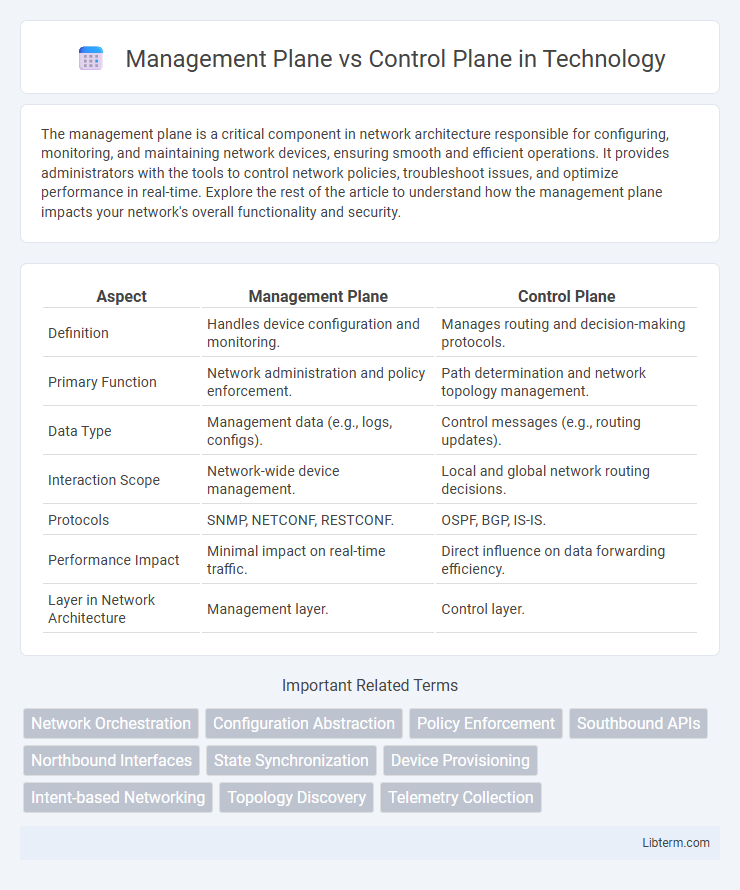The management plane is a critical component in network architecture responsible for configuring, monitoring, and maintaining network devices, ensuring smooth and efficient operations. It provides administrators with the tools to control network policies, troubleshoot issues, and optimize performance in real-time. Explore the rest of the article to understand how the management plane impacts your network's overall functionality and security.
Table of Comparison
| Aspect | Management Plane | Control Plane |
|---|---|---|
| Definition | Handles device configuration and monitoring. | Manages routing and decision-making protocols. |
| Primary Function | Network administration and policy enforcement. | Path determination and network topology management. |
| Data Type | Management data (e.g., logs, configs). | Control messages (e.g., routing updates). |
| Interaction Scope | Network-wide device management. | Local and global network routing decisions. |
| Protocols | SNMP, NETCONF, RESTCONF. | OSPF, BGP, IS-IS. |
| Performance Impact | Minimal impact on real-time traffic. | Direct influence on data forwarding efficiency. |
| Layer in Network Architecture | Management layer. | Control layer. |
Introduction to Network Planes
Network planes are divided into management, control, and data planes, each serving distinct roles in network architecture. The Management Plane handles configuration, monitoring, and administration tasks, ensuring network devices operate efficiently and securely. The Control Plane is responsible for network routing and signaling, making decisions about data path selection and maintaining routing tables to direct traffic flow accurately.
Definition of Management Plane
The Management Plane refers to the layer in network architecture responsible for configuring, monitoring, and maintaining network devices and services. It provides administrators with tools and interfaces to control policies, perform updates, and gather performance data without directly handling the traffic flow. Distinct from the Control Plane which manages routing decisions, the Management Plane ensures overall network management and operational oversight.
Definition of Control Plane
The Control Plane is the network component responsible for making decisions about where traffic is sent by managing routing tables and network topology information. It communicates with the data plane to instruct packet forwarding based on established policies and protocols such as OSPF, BGP, or MPLS. Unlike the Management Plane, which handles configuration and monitoring, the Control Plane dynamically controls the flow of data across the network infrastructure.
Key Functions of the Management Plane
The Management Plane is responsible for the overall configuration, monitoring, and administration of network devices, enabling centralized control and policy enforcement. It facilitates tasks such as device provisioning, firmware updates, performance monitoring, and security management through management protocols like SNMP, NETCONF, and RESTCONF. This plane ensures network stability and operational efficiency by maintaining the system's state and providing interfaces for human operators and network management systems.
Key Functions of the Control Plane
The Control Plane is responsible for routing decisions, network topology discovery, and maintaining the routing tables that dictate the path data packets take through the network. It handles protocols such as OSPF, BGP, and MPLS, ensuring efficient and dynamic route computation. Key functions include route calculation, traffic engineering, and policy enforcement to optimize network performance and reliability.
Differences Between Management and Control Planes
The Management Plane handles configuration, monitoring, and administration of network devices, ensuring operational oversight and policy enforcement, while the Control Plane manages the routing and signaling protocols that determine the path of data packets through the network. The Control Plane operates in real-time to establish and maintain network topology, whereas the Management Plane functions with lower frequency tasks centered on device status and configuration updates. Differences include their roles: the Management Plane focuses on network oversight and settings, whereas the Control Plane dynamically controls traffic flow and routing decisions.
Importance of Separation Between the Planes
Separation between the management plane and control plane is crucial for network security and stability, allowing administrators to manage devices without interfering with real-time data forwarding. This distinction prevents potential configuration errors or attacks from affecting the control plane, which is responsible for routing decisions and network topology maintenance. Ensuring isolation between these planes enhances fault tolerance and simplifies troubleshooting by maintaining clear operational boundaries within network infrastructure.
Security Implications: Management vs. Control Plane
The Management Plane handles device configuration and policy enforcement, making it a prime target for administrative access attacks, requiring robust authentication and encryption protocols to prevent unauthorized control. The Control Plane processes routing and signaling information, so vulnerabilities here can lead to traffic interception or network disruption, necessitating strict validation of control messages and protection against spoofing. Securing both planes is critical: the Management Plane demands hardened access controls to safeguard configuration integrity, while the Control Plane requires mechanisms to ensure the confidentiality and correctness of routing information to maintain overall network stability.
Real-World Use Cases and Examples
The management plane enables network administrators to configure, monitor, and maintain devices through protocols like SNMP and NETCONF, essential for tasks such as firmware updates and policy enforcement in enterprise networks. The control plane handles routing decisions and network topology discovery using protocols like OSPF and BGP, ensuring optimal path selection and traffic management in service provider environments. Real-world examples include SDN architectures where the control plane dynamically adjusts routing flows, while the management plane provides centralized device management and policy application.
Best Practices for Managing Network Planes
Effective management of network planes requires clear separation between the management plane and control plane to enhance security and operational efficiency. Best practices include implementing robust access controls and encryption for management plane traffic, while ensuring the control plane has optimized protocols for real-time network routing and signaling. Regular monitoring and segmentation of these planes reduce risks of unauthorized access and improve fault isolation.
Management Plane Infographic

 libterm.com
libterm.com